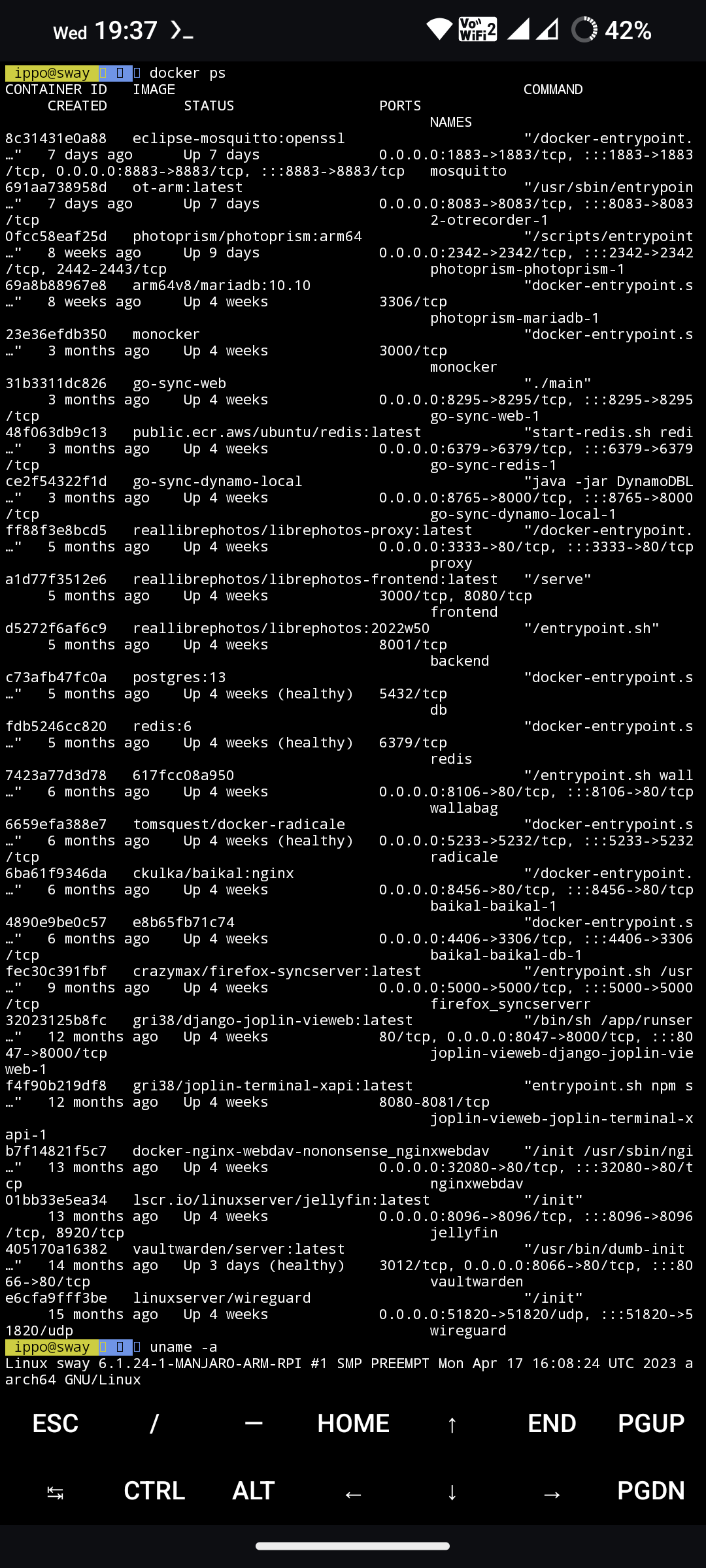For those of you who use Raspberry Pi’s in your home environment, I’m curious as to what you use them for. What applications are you running on them? Do you have your Pi’s setup in a cluster?
I own a raspberry pi 4. Every time I try to use it, I spend half my time trying to fix the stuttery/non responsive UI by fucking with the compistor and such. And then I give up.
I eventually got a new gaming PC and turned my old one into a Linux server, and haven’t really touched my Raspberry Pi since.
I’ll give you $5 for it!
And I’ll give you $10 for it
Sold!!
Try running a server image on it without desktop and then logging into it over the network from another device like a laptop via ssh
My usecase required a GUI. I was trying to have a mini PC connected to my TV to watch live sports games in a web browser (pirated streams). I was getting micro stutters with a raspberry pi, which made sports unwatchable.
I had similar problems doing the same thing with a Pi 4.
RPI4/400 is perfectly capable as a little home server. All it needs is a good SD card.
Owntracks,photoprism,monocker,brave go m-sync,libre photos,wallabag,radicals e,Baikal,Firefox sync,Joplin web,webdav server,jellyfin,vaultwarden,wireguard

Get an eMMC module ($10) for the Pi or buy something similar with one built-in. Much faster and more reliable.
I snagged an enclosure with a little adapter for a SATA m.2 drive. It’s amazing!
Hey where? I need that! Have a spare m2 and want to use it!
https://www.amazon.com/dp/B08MJ3CSW7
This is my case! It only takes SATA m.2 drives, which which I also had a spare of sitting around!
So now I have this badass SSD pi4 4GB and all it does is share a 5TB hard drive between all my computers through OMV.
I need to learn how to do a docker. I HAVE FAILED at docker and Portainer. All I want is to have it also torrent through a VPN.
Edit: OH AND I FORGOT it turns your rubbish mini HDMI bullshit ass dick connectors into REAL HDMI
Hmmm, I’m just using OMV on mine to make it a server that I can use to transfer files around my house.
Do you have any tips on where I could get started doing more? I haven’t had success with Docker or Portainer and I’d love to have some software hosting files like OMV, and a torrent client running through a VPN in another container.
OMV is quite limiting and maybe a little heavy for the pi(?)
Docker is straightforward Idk what to say You install docker and docker compose on host and run some compose.yml’s to spin up your services
I’m an extreme a Linux nub… would you happen to have any further reading or videos you would recommend? Without OMV, how would I share my HDD on my network?
I use https://github.com/dgraziotin/docker-nginx-webdav-nononsense
There are many dockerised fileservers
Magnificent, I’ll look into this!
If I re-set up everything outside of OMV, will I need to reformat the HDD that’s being shared?
Removed by mod
I’m running an Argon for that sweet SSD action as well!
I’m only using OMV right now and it works, but I’d LOVE to get a container with torrents via VPN… I can’t do it, though. I’m awful at it. Do you have any resources on how to set up Portainer? It changed recently, and was a weeeeird process to set up in OMV.
This lemmy instance is running on my Pi
Lets see…
- nord vpn client
- qbittorrent (through nord vpn)
- proxy server (through nord vpn)
- wireguard vpn server
- ssh client so I can port forward through the vpn server to/from connected clients
- jellyfin
- ntfy (self hosted notifications)
- pi-hole (vital for the local dns)
- nginx
- gitea
- wallabag
- minecraft server
- container registery
- smb share for my friend (I help them with content creation)
- smb share for a live recording profile I set up on android
Those are just docker containers, it also is a backup server for all the devices I own. It also runs all non sensitive data on an unencrypted partition then will auto decrypt the sensitive partion through ssh via my desktop. This means my vpn server will always run so I can connect, wake on lan my desktop, decrypt it and log in. Im sure I’m missing things.
My list is very similar but I have my Pis in a k3s cluster with a NAS for PVs. That allows me to not worry about what physical device is hosting the service, and I built it so I can intermix amd64 devices when I start adding in my used laptops into the mix.
I have one pi (rpi 4b) that I still use. I have it in an Argon One V2 case for the daughter board that lets me boot from an M.2 SATA SSD. I got tired of the corrupted SD cards. It’s actually reliable now.
Anyway, I mainly only use it because in the event of a power outage, as soon as power is restored, it automatically turns on. If I’m not home, I can SSH back into my network and send a WoL packet to my actual server to turn it back on.
The pi also runs:
- Scrypted so I can view my ring cameras in the Apple Home app and so I get the “someone is at the door” notifications on my Apple TV
- Pi-Hole
- Pi-VPN
I feel old, I don’t understand 90% of words in this thread lol.
I just have kodi on Libreelec with a jellyfin plugin on my rpi4 and even that struggled with overheating at times. So I run most stuff on my pc instead. I’m tempted to try the portainer to get some experience with docker tho.
Removed by mod
Really? I’ve seen threads with people claiming to run dozens of services on it. What do you recommend instead, just any rpi OS and installing them like I would on regular linux?
Removed by mod
I have k3s running on my Pi cluster and have dozens of services running on them. USB drives for the lot of them.
Removed by mod
Sure! I’m using ansible to manage the hosts, install k3s, and deploy the manifests. I’m looking at switching to nixos for reproducibility purposes. I have a couple Pi 4’s, and a handful of Pi 3Bs. Each one is booting off USB drives (Pi 4s have SSDs and others have thumb drives). Then I have an old computer I turned into a NAS server that is hosting NFS for the PVs of each pod. Then I have a rackmount gigabit switch, and I set up tailscale on each node, and reference everything by the tailnet names. Works really well and I have complete access while I’m away from home.
Edit: oh yea my NFS server is also hosting a docker server. My ansible stages the docker containers to the local docker server then each pod pulls from the local server to save on bandwidth and if internet goes down I can still do everything locally.
I have a Pi4 running octoprint, pi-hole and some of my own containers.
The rest I run on a Hetzner VM.
Cluster of Pi4 8GBs. Bought pre-pandemic; love the little things.
Nomad, Consul, Gluster, w/ TrueNas-backed NFS for the big files.
They do all sorts of nifty things for us including Nightscout, LanguageTool OSS, monitoring for ubiquiti, Nextdrive, Grafana (which I use for home monitoring - temps/humidity with alerts), Prometheus & Mimir, Postgres, Codeserver.
Basically I use them to schedule dockerized services I want to run or am interested in playing with/learning.
Also I use Rapsberry Pi zero 2 w’s with Shairport-sync (https://github.com/mikebrady/shairport-sync ) as Airplay 2 streaming bridges for audio equipment that isn’t networked or doesn’t support AirPlay 2.
I’m not sure I’d buy a Pi4 today; but they’ve been great so far.
Home security system, VPN, DNS server with pihole.
security? For surveillance or something more?
Wireless Z-wave module, door sensors, fire alarm, motion sensors, hidden on/off switch. Raspberry itself works as the camera and has motion detection if needed. Event notices are sent using xmpp.
Very interesting. So you basically have an alarm system in software then? What do you use for software? Do you have an arm/disarm function?
Raspberry Z-wave module came with rudimentary software, that was just awful. Documentation and debug tools were utter crap and I never want to do that kind of trial and error bs ever again.
I basicly use the software to pass trigger events to linux and handle the timing and remote UI. Linux commandline clients then handle sending messages, capturing images/video and sending captured material to a cloud server.
Software allows remote control through webpage, that you can access either directly in LAN or through an obscure server that uses reverse SSH to get past your firewal.
I blocked the shady SSH connection and only use it directly through my VPN.
I assume by “Raspberry Z-Wave module” you mean the RaZberry z-wave addon board, and I couldn’t agree more. I tried to get that thing going with another home automation package and gave up after a few hours of fucking with it.
That said, these days I’m using Home Assistant on a RPi with a Nortek z-wave/zigbee combo radio USB interface and I couldn’t be happier. If you’ve never used HA it’s worth trying out; used to require a lot of scripting but now it’s a beautiful and polished system that has all the tweakability a nerd wants with a nice high-WAF GUI. They have a plugin that does exactly what you’re doing and makes a virtual alarm system out of existing sensors.
I also agree block connections and use a VPN to access it, I do the same thing.
I have one Pi 4b for my Homeassistant. It is fixed to a wall, next to the routers, running 24/7.
I did not want to include this on my other Homeserver to avoid the dependency.
I use rasp as Bluetooth receiver for my home assistant sensors (Ruuvi tags mainly)
This is basically my setup except I don’t have any other homeserver stuff yet :) (I will once I build my new gaming pc, planning to use my old one for that stuff)
I have 6 4b’s running PiCorePlayer for home audio. I control them with LMS and can sync them or play different things in different rooms.
I’m curious about your setup, did you follow a particular guide and what kind of speakers are they connected to? Thanks!
I don’t think I followed a specific guide. I’m using the HifiBerry Amp2 amplifier with the Pis. The house I moved into had Bose in-wall speakers in a couple of rooms and I added some in-ceiling speakers and a couple of outdoor speakers. Most of the speaker wires are routed down to the basement, so I can have all the Pis connected right to the switch via Ethernet.
Running speaker cable is by far the hardest thing about this. You could also connect the Pis via Wi-fi; I haven’t tried that but it is supposed to work pretty well.
On the software end, it’s pretty simple. PiCorePlayer is just an image you burn to an SD card and boot up on the Pis. I run LMS in a docker container. As long as the PiCorePlayer instances and LMS are all on the same subnet, they will auto-discover each other. If they’re not, it’s just a matter of configuring the LMS server URL on the PiCorePlayers.
LMS configuration is also pretty simple… you point it at your music folder and it will scan and index your MP3s and other audio files. It has plugins for Spotify, Tidal, Youtube, and some other apps. You can control it via browser, or there are Android and iOS mobile apps.
Once you buy the Pis, amps, power supplies, and cases, you are looking at probably $140 or so per zone… so it’s not entirely cheap, but I think it’s cheaper than Sonos or other pre-built systems. It sounds great and the different Pis sync very well. I don’t hear any sync issues walking from zone to zone.
RPi 4B > DietPi > Pi hole + Unbound.
I used to run pretty much all my workloads on Raspberry Pis, mostly in docker containers. I’ve since moved over to some ex enterprise servers and Proxmox, so I really only have a couple of Pis left in service, running:
- Frigate: nvr for my IP cameras
- exim: mail relay server for my stuff to be able to email out (nothing in)
- Wireguard: outbound VPN server connected to Mullvad
- Pi-hole: 2nd instance for redundancy, also runs cloudflared (for DNSoHTTP) and pihole-exporter (for putting Pi-hole stats into Prometheus)
- Mosquitto: because I haven’t moved it yet
- Prometheus: ditto
Octopi








